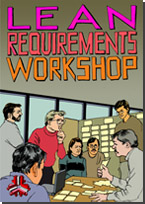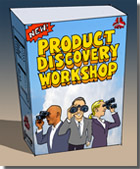
Transfer %
Knowledge: 60%, Skill-Building: 40%Learning Outcomes
- Understand the risks in new product development and how an evolutionary approach addresses them
- Be able to describe your business using the business model canvas
- Learn to identify a minimum viable product, so you don't over-invest in a poor direction
- Learn to detect when your team needs to pivot to a new offering or sales channel
- Understand how vanity metrics such as number of customers can be misleading, and what you want to measure instead
- Learn about tools such as Continuous Delivery that support a high-intensity team
Method of Instruction
A mix of Interactive Dialogs, Exercises, Lectures, Live and/or Video Demonstrations, and Instructional SimulationTarget Audience
- Primary: All members of a software development team (technical or not)
Course Level
Introductory/IntermediateCourse Prerequisites
- Required: An open mind
- Highly Recommended: Basic understanding of the lifecycle of software projects
We can customize the contents and agenda to best suit your needs.
- Primary: All members of a software development team (technical or not)
Course Level
Introductory/IntermediateCourse Prerequisites
- Required: An open mind
- Highly Recommended: Basic understanding of the lifecycle of software projects
Contents
| Startups and Lean |
| Exercise: Observing Users |
| Lean Startup Principles |
| How a Startup Works |
| Exercise: Estimating Market Size |
| Case Studies: Lean Startup Principles in Action |
| Customer Development: Get Out of the Building |
| Exercise: Customer Interview |
| The Business Model Canvas |
| Exercise: Your Business Model |
| The Minimum Viable Product |
| Exercise: Closing in on an MVP |
| Innovation Accounting |
| Exercise: Fill the Funnel |
| Pivot: Change Direction Without Starting Over |
| Exercise: Pivot or Perish |
| Planning and Steering |
| Exercise: Span Plan |
| Kanban |
| Continuous Delivery |
| Exercise: How Far is CD? |
| Lean Startup Simulation |
| Applying Lean Startup Ideas In Your Environment |
Related Items
Request a Quote
Transfer %
Knowledge: 60%, Skill-Building: 40%Learning Outcomes
- Understand the risks in new product development and how an evolutionary approach addresses them
- Be able to describe your business using the business model canvas
- Learn to identify a minimum viable product, so you don't over-invest in a poor direction
- Learn to detect when your team needs to pivot to a new offering or sales channel
- Understand how vanity metrics such as number of customers can be misleading, and what you want to measure instead
- Learn about tools such as Continuous Delivery that support a high-intensity team
Method of Instruction
A mix of Interactive Dialogs, Exercises, Lectures, Live and/or Video Demonstrations, and Instructional SimulationTarget Audience
- Primary: All members of a software development team (technical or not)
Course Level
Introductory/IntermediateCourse Prerequisites
- Required: An open mind
- Highly Recommended: Basic understanding of the lifecycle of software projects
We can customize the contents and agenda to best suit your needs.
- Primary: All members of a software development team (technical or not)
Course Level
Introductory/IntermediateCourse Prerequisites
- Required: An open mind
- Highly Recommended: Basic understanding of the lifecycle of software projects
Contents
| Startups and Lean |
| Exercise: Observing Users |
| Lean Startup Principles |
| How a Startup Works |
| Exercise: Estimating Market Size |
| Case Studies: Lean Startup Principles in Action |
| Customer Development: Get Out of the Building |
| Exercise: Customer Interview |
| The Business Model Canvas |
| Exercise: Your Business Model |
| The Minimum Viable Product |
| Exercise: Closing in on an MVP |
| Innovation Accounting |
| Exercise: Fill the Funnel |
| Pivot: Change Direction Without Starting Over |
| Exercise: Pivot or Perish |
| Planning and Steering |
| Exercise: Span Plan |
| Kanban |
| Continuous Delivery |
| Exercise: How Far is CD? |
| Lean Startup Simulation |
| Applying Lean Startup Ideas In Your Environment |

